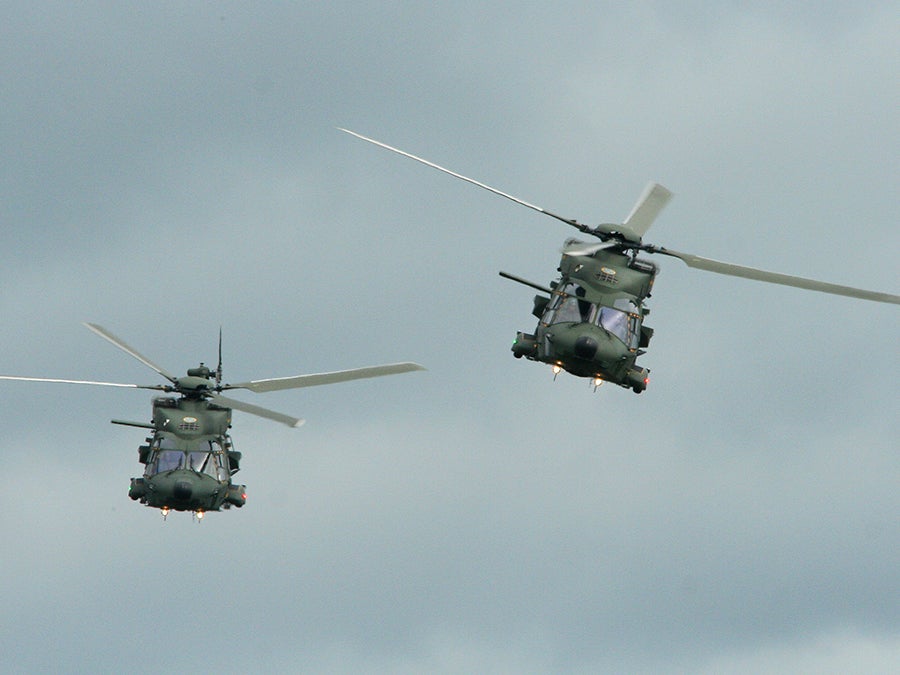
The Swedish Air Force is assessing the effectiveness and performance of its NH90 anti-submarine warfare (ASW) helicopter, with the platform deemed as not currently delivering its planned capabilities to the country’s military, it has emerged.
In 2001, the Swedish Air Force signed the purchase contract for 18 NH90 helicopters, classified as the HKP14, as well as seven on option, receiving the first ASW platform in 2015. The Swedish acquisition included nine in the land-based roles and the remaining nine in naval roles, receiving the eighteenth and final HKP14 in 2019.
Speaking at a Swedish Air Force event in London on 17 July, Major General Carl-Johan Edstrom, commander of the Swedish Air Force, said the NH90 was “not delivering what it should deliver at the moment”, as the service conducts a wider review of its rotary requirements.
Edstrom said it was a “big decision” as to what Sweden would do with its NH90 fleet, and that the country was in dialogue with other operators on the platform.
By contrast, the UH-60M Black Hawk fleet was “really working well” for the Swedish military, Edstrom said.
The NH90 suffered a notable reversal earlier this year, after Norway opted to cancel its own NH90 programme and said it would be seeking “full restitution of funds and assets received by both parties”, amounting to around NOK5bn it has paid in the contract, in addition to interest and other expenses.
How well do you really know your competitors?
Access the most comprehensive Company Profiles on the market, powered by GlobalData. Save hours of research. Gain competitive edge.

Thank you!
Your download email will arrive shortly
Not ready to buy yet? Download a free sample
We are confident about the unique quality of our Company Profiles. However, we want you to make the most beneficial decision for your business, so we offer a free sample that you can download by submitting the below form
By GlobalData“We have made repeated attempts at resolving the problems related to the NH90 in cooperation with NHI, but more than 20 years after the contract was signed, we still don’t have helicopters capable of performing the missions for which they were bought,” the Norwegian Defence Material Agency said in a 10 June statement.
The NATO frigate helicopter (NFH) is one of two versions of the NH90 twin-engine multirole helicopter, manufactured by NHIndustries, with the other version designated the NH90 TTH (tactical transport helicopter). NHIndustries, the prime contractor for the programme, is a joint venture company between Airbus Helicopters, Leonardo, and GKN Fokkerr.
According to NHIndustries the programme is the largest of its kind launched in Europe, with more than 500 units ordered for France, Germany, Italy, the Netherlands, Portugal, Finland, Norway, Sweden, Greece, Oman, Australia, New-Zealand, Spain and Belgium.
By April 2021, 444 NH90 aircraft were declared as operational across 13 countries, with more than 100 naval NH90 helicopters delivered to six nations by November 2020.
Elsewhere, Edstrom said the first four C-130H transporters will be replaced by the J model from 2028, in addition to outlining that Sweden’s future fighter fleet will comprise a mix of around 60 Gripen C/D and 60 Gripen E, across seven combat fighter squadrons, as the country seeks to increase defence spending to 2% of GDP.
A national strategy document will be published in November outlining what platform could replace the older Gripen C/D aircraft currently in service.
In June, Sweden announced its intention to join NATO, a move influenced by Russia’s large-scale invasion of Ukraine on 24 February. The NATO benchmark asks members to contribute 2% of their national GDP to national defence spending.







